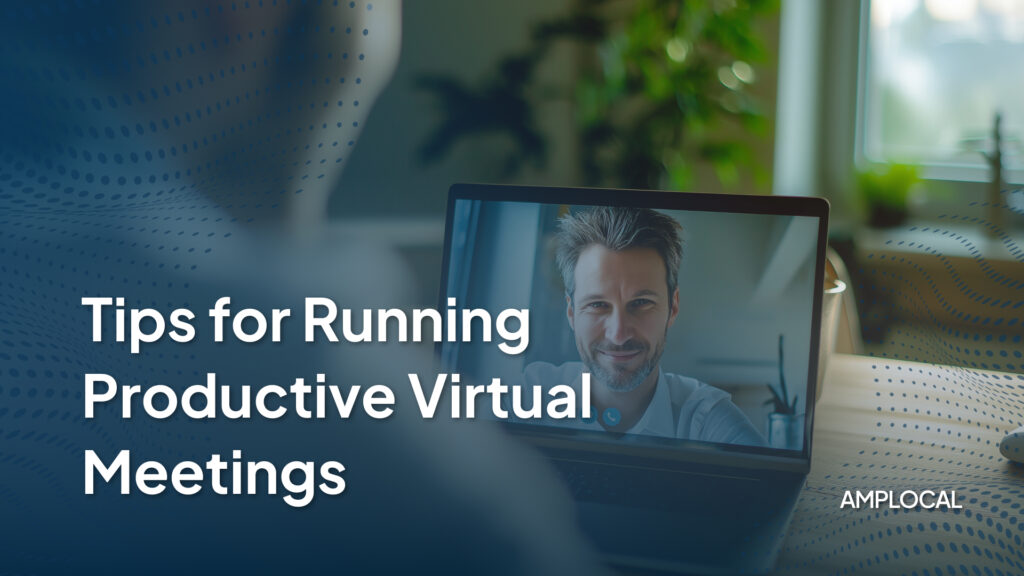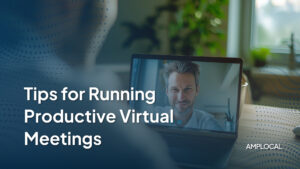The shift to remote and hybrid work has made virtual meetings a cornerstone of business communication, particularly for companies in Medford, Oregon, and throughout the Rogue Valley. Learning to conduct productive virtual meetings has become essential for maintaining team collaboration and business efficiency. Whether you’re managing a local team in Southern Oregon or coordinating with colleagues across different time zones, mastering digital meeting etiquette can transform your virtual gatherings from time-wasters into powerful collaboration tools.
The Foundation of Productive Virtual Meetings
Understanding what makes virtual meetings different from in-person gatherings is crucial for success. Productive virtual meetings require more intentional planning, clearer communication protocols, and enhanced engagement strategies to overcome the natural barriers of digital communication. For businesses throughout the Rogue Valley, these skills have become essential for maintaining strong team dynamics in increasingly distributed work environments.
The technology itself presents both opportunities and challenges for productive virtual meetings. While video conferencing platforms offer features like screen sharing, breakout rooms, and recording capabilities, they also introduce potential distractions and technical difficulties. Successful meeting facilitators learn to leverage technology advantages while minimizing common pitfalls that can derail virtual collaboration.
Creating productive virtual meetings also requires acknowledging the unique fatigue factors associated with video conferencing. “Zoom fatigue” has become a real phenomenon affecting meeting effectiveness and participant engagement. Understanding these challenges allows meeting organizers to design experiences that work with human psychology rather than against it.
The most productive virtual meetings establish clear expectations and protocols that all participants understand and follow. This structure becomes even more important in virtual environments where non-verbal communication is limited and multitasking temptations are greater. For teams in Southern Oregon managing both remote and in-office staff, consistent meeting protocols ensure everyone can participate effectively regardless of their location.
Pre-Meeting Preparation for Success
Every productive virtual meeting begins with a well-defined purpose and structured agenda. Before scheduling any virtual gathering, clearly articulate what you hope to accomplish and whether the objectives truly require a meeting format. This evaluation helps prevent unnecessary meetings that waste valuable time for busy professionals throughout Medford and the broader Oregon business community.
Distribute detailed agendas at least 24 hours before your productive virtual meetings to give participants time to prepare. Include specific topics, time allocations, required pre-work, and clear action items expected from each participant. This preparation level ensures everyone arrives ready to contribute meaningfully to the discussion rather than spending meeting time getting up to speed.
Consider the optimal meeting length for virtual formats, which is typically shorter than in-person equivalents. Most productive virtual meetings should run 30-45 minutes maximum, with complex topics broken into multiple focused sessions rather than single marathon meetings. For businesses in the Rogue Valley managing multiple time zones, shorter meetings also accommodate scheduling constraints more effectively.
Share relevant documents, presentations, or background materials before the meeting begins. This pre-distribution allows participants to review materials thoroughly and come prepared with questions or feedback. Productive virtual meetings move more efficiently when everyone has context before the session starts.
Technical Setup and Environment
Reliable technology forms the backbone of productive virtual meetings. Test your audio, video, and internet connection before important meetings to prevent technical disruptions that can derail discussions. For professionals working from home offices throughout Southern Oregon, investing in quality headphones or microphones significantly improves communication clarity.
Choose an appropriate virtual background or ensure your physical background is professional and non-distracting. Lighting should illuminate your face clearly without creating shadows or glare. These technical considerations may seem minor but significantly impact how professional and engaging your productive virtual meetings appear to participants.
Prepare backup plans for technical failures that might disrupt your meeting flow. This includes having phone dial-in options available, sharing presentation materials in advance, and designating someone to help troubleshoot participant technical issues. These contingencies ensure productive virtual meetings can continue even when technology doesn’t cooperate perfectly.
Close unnecessary applications and silence notifications to minimize distractions during your productive virtual meetings. The temptation to multitask during virtual meetings is significantly higher than in-person gatherings, making focused attention more challenging but also more important for meeting success.
Need help implementing virtual meeting strategies for your team? Contact our Medford office today.
During the Meeting: Engagement and Facilitation
Successful facilitation of productive virtual meetings requires more active management than in-person gatherings. Start meetings with brief check-ins that allow each participant to speak early, setting the tone for active participation throughout the session. This technique helps identify technical issues and ensures everyone feels included from the beginning.
Use direct questioning and name-calling to encourage participation in productive virtual meetings. The virtual format makes it easier for participants to remain passive, so facilitators must be more intentional about drawing out contributions from all attendees. For teams in the Rogue Valley with varying comfort levels with technology, this inclusive approach ensures everyone can contribute effectively.
Implement structured discussion formats that prevent productive virtual meetings from becoming dominated by the loudest voices. Techniques like round-robin sharing, polling, or breakout room discussions create opportunities for all participants to contribute meaningfully. These structured approaches work particularly well for teams spread across different Oregon locations.
Monitor participant engagement through both verbal and visual cues available in the virtual environment. Watch for signs of disengagement such as multitasking, lack of video participation, or minimal verbal contribution. Address engagement issues promptly to maintain the energy and focus necessary for productive virtual meetings.
Communication Best Practices
Establish clear communication protocols that all participants understand and follow during productive virtual meetings. This includes guidelines for muting/unmuting, hand-raising for questions, and appropriate use of chat functions. Consistent protocols reduce confusion and ensure smooth meeting flow regardless of participants’ technical expertise.
Speak clearly and at an appropriate pace for virtual communication, which often requires slight adjustments from natural in-person speaking patterns. Brief pauses between speakers become more important in productive virtual meetings to prevent overlapping conversations that can be confusing in digital formats.
Use the chat function strategically to enhance productive virtual meetings without creating distractions. Chat works well for sharing links, capturing action items, or allowing quiet participants to contribute questions. However, excessive chat activity can become distracting, so establish guidelines for appropriate usage.
Summarize key points and decisions regularly throughout productive virtual meetings to ensure understanding and maintain focus. The virtual format can make it easier for participants to lose track of the discussion flow, making periodic summaries more important than in face-to-face meetings.
Visit our local office to learn more about our team collaboration strategies.
Post-Meeting Follow-Through
Document key decisions, action items, and next steps immediately after productive virtual meetings while details remain fresh. Share these notes with all participants within 24 hours, including clear ownership assignments and deadlines for follow-up actions. This documentation becomes particularly important for virtual meetings where participants may have been managing multiple distractions.
Schedule necessary follow-up meetings or check-ins while momentum from productive virtual meetings remains high. Virtual work environments can make informal follow-up conversations more challenging, so formal scheduling becomes more important for maintaining project progress.
Solicit feedback about meeting effectiveness to continuously improve your productive virtual meetings. This feedback might address technical issues, facilitation techniques, or agenda structure. For teams throughout Oregon adapting to virtual collaboration, this continuous improvement approach helps develop meeting practices that work for your specific group dynamics.
Advanced Techniques for Virtual Meeting Excellence
Leverage platform-specific features to enhance productive virtual meetings beyond basic video conferencing. Screen sharing, annotation tools, virtual whiteboards, and breakout rooms can transform passive meetings into interactive collaboration sessions. Experiment with these features during less critical meetings to build confidence before using them in important business discussions.
Consider hybrid meeting formats that accommodate both in-person and virtual participants effectively. These mixed formats require additional planning but can be essential for businesses in Medford serving both local and remote team members. Successful hybrid meetings ensure virtual participants feel equally included and engaged.
Conclusion
Mastering the art of productive virtual meetings has become essential for business success in our increasingly digital world. By implementing proper preparation techniques, engagement strategies, and follow-through practices, you can transform virtual meetings from necessary evils into powerful collaboration tools. For businesses throughout the Rogue Valley and beyond, these skills enable effective teamwork regardless of physical location.
Remember that productive virtual meetings require ongoing refinement and adaptation as technology and team dynamics evolve. Stay open to feedback, experiment with new techniques, and continuously work to improve your virtual facilitation skills. The investment in developing these capabilities pays dividends through improved team productivity and collaboration.
Ready to enhance your team’s virtual collaboration capabilities? Our team specializes in helping businesses throughout Southern Oregon optimize their digital communication strategies. Contact us today to learn how we can help your organization conduct more productive virtual meetings that drive real business results.
Frequently Asked Questions
Q: How long should productive virtual meetings last compared to in-person meetings?
A: Productive virtual meetings should generally be 25-50% shorter than equivalent in-person meetings due to increased cognitive load from video conferencing. Most effective virtual meetings run 30-45 minutes maximum, with complex topics broken into multiple focused sessions. For businesses in Medford managing team collaboration, shorter meetings help maintain participant attention and energy while accommodating the technical demands of virtual communication that can be more mentally taxing than face-to-face interaction.
Q: What technology do I need to ensure productive virtual meetings?
A: Essential technology for productive virtual meetings includes reliable high-speed internet, quality audio equipment (headset or external microphone), proper lighting for video clarity, and a backup internet connection when possible. For professionals throughout the Rogue Valley, investing in a good webcam and noise-canceling headphones significantly improves meeting quality. Additionally, ensure you’re familiar with your chosen platform’s features like screen sharing, breakout rooms, and recording capabilities that can enhance meeting productivity and engagement.
Q: How can I keep participants engaged during productive virtual meetings?
A: Maintain engagement in productive virtual meetings by using interactive elements like polls, breakout discussions, and direct questioning of participants by name. Start with check-ins, vary presentation formats, encourage video participation, and limit meeting length to prevent fatigue. For teams in Southern Oregon, incorporating local references or regional business examples can help maintain connection and relevance. Use features like virtual whiteboards and screen sharing to create visual engagement that keeps participants actively involved rather than passively listening.
Q: What’s the best way to handle technical difficulties during productive virtual meetings?
A: Prepare for technical issues in productive virtual meetings by having backup plans including phone dial-in options, pre-shared materials, and designated technical support. When problems occur, address them quickly but don’t let them derail the entire meeting. For businesses in Oregon, having a technical point person who can help troubleshoot participant issues while the meeting continues ensures productive virtual meetings stay on track. Always start meetings a few minutes early to identify and resolve technical problems before the formal agenda begins.
Q: How do I manage time zones effectively for productive virtual meetings with distributed teams?
A: Schedule productive virtual meetings by finding optimal times that minimize inconvenience for the majority of participants, rotating meeting times when serving global teams, and using scheduling tools that show multiple time zones clearly. For businesses in Medford coordinating with teams across Oregon or nationally, consider recording meetings for those who cannot attend live. When time zone conflicts are unavoidable, ensure comprehensive meeting notes and follow-up communications keep all team members informed and engaged regardless of their ability to attend productive virtual meetings in real-time.




